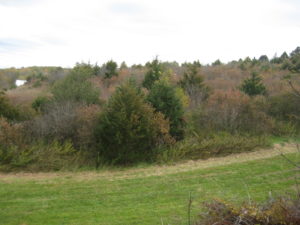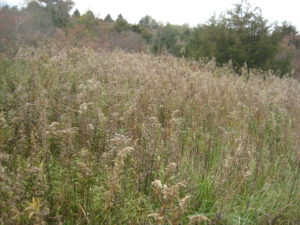Where are the Savanna Birds?
A third of a century ago, savannas were considered to be merely transition zones, viewed as either thinly wooded prairie or grassy open forest. With this mindset, Steve Packard, an Illinois prairie activist, set out to convert a brushy Illinois pasture back to savanna. Some old spreading bur oaks were already present, so all he had to do was get rid of the exotic brush and plant some prairie grasses and forbs. Simple. Except that it didn’t work.
Someone referred Steve to an old journal, kept by a frontier doctor, when Illinois was “the West.” His plant lists began to look familiar to Steve because they included many of the survivors of his savanna trials. Using the doctor’s notes as a guide, he located other species in the fields which were also adapted to the presence of the big trees, and thus he gradually developed the philosophy that whichever natives could handle partial shade, plus fire, probably belonged there. The Midwestern savanna plant community has thus come to be defined experimentally, having been obliterated so completely that no one living has seen an intact one.
After a few years of such efforts, Steve began to think the savannas were a distinctive type of habitat.
Many historical studies and field experiments are now under way, and the term savanna is gradually coming to encompass habitats that the original land surveyors referred to as barrens, oak openings, balds, lightly timbered prairie, and limestone glades, each of which have their own unique communities of plants.

This former hayfield was last mowed in 1993, now in dense shrubs with a few trees starting to break through the shrub canopy.
With the savanna habitat now somewhat better defined, what about the savanna birds? Experience generally shows that when habitats vanish, so do many of those animals dependent upon that habitat. Yet we know of few Midwestern bird species that have become extinct. The demise of the passenger pigeon is one well-documented exception, and this was apparently a creature of both savanna and forest. Was there originally a community of birds which specialized in savanna habitats and which had only minor proportions of forest and prairie species? If so, then as the savannas vanished, perhaps their bird species diminished and became a minor component in the agricultural landscape, confined to those habitats which were acceptably similar to the old savannas.
Our expectations regarding the original savanna birds should be affected by how shrubby we think savannas were. The old literature is quite varied on this subject. At one extreme, early written accounts describe “timbered prairie” as open as manicured parks, so that one could drive carriages anywhere through them or shoot deer at great distances. At the other extreme are stories of prairie travelers passing through brushland so thick they had to lead their horses through, or of encountering a bear face-to-face because they could see only a few feet ahead. In a general way this resembles the modern landscape divided into a patchwork of agricultural land, with variable shrubby areas growing and vanishing in woodlots, pastures, and fencerows, along creek banks and “B” level roads, and more extensively in parks, preserves, and conservation acreages. This might explain why so few Midwestern savanna bird extinctions are known. The odd little brushy corners, which even conservationists wouldn’t find very exciting, may collectively be serving as substitutes for now-vanished savannas.

Same former hayfield as above, this portion dominated by brome grass and oldfield goldenrod.
Carol Thompson, co-author of the Iowa Breeding Atlas, suggests that the chat, northern mockingbird, orchard oriole, eastern bluebird, eastern kingbird, indigo bunting, yellow warbler, and warbling vireo are savanna candidates, because today they can most often be found in overgrown pastures, young second-growth woods, and woodland edges. Other possibilities, with even less known about them, include the chestnut-sided and prairie warblers, white-eyed vireo, and blue grosbeak. Today the blue-winged and golden-winged warblers and Bell’s vireo inhabit the more shrubby areas, a habitat perhaps comparable to the hazel ruff and other shrubby transition zones of our former savannas.
Will we ever really know much about our savanna birds? Perhaps. Savanna restoration efforts are now under way, especially in Illinois and Missouri; a few have been launched in Iowa. If good records are kept, perhaps we will see a shift in bird populations in restored areas, which is one reason why the Breeding Bird Survey and other baseline studies are important. Just as the flora of restored savannas is becoming defined as “whatever works,” so will the savanna fauna. However, “whatever works” for birds will also include other components, such as availability of winter habitat for neotropicals, pesticide effects, cats and cowbird management, so experimentation can at best be only an approximation of former savannas. It took about a century to destroy our savannas and it will probably require another century to bring some of them back. We had better get started.
Originally published by the Johnson County Songbird Project, winter 1994. Used with permission from Jim Walters.


